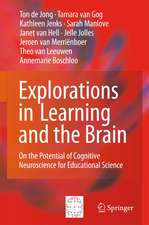Structure and Function in Excitable Cells
Editat de Donald Chengen Limba Engleză Paperback – 12 feb 2012
Preț: 654.62 lei
Preț vechi: 770.14 lei
-15% Nou
Puncte Express: 982
Preț estimativ în valută:
125.27€ • 129.43$ • 104.20£
125.27€ • 129.43$ • 104.20£
Carte tipărită la comandă
Livrare economică 19 martie-02 aprilie
Preluare comenzi: 021 569.72.76
Specificații
ISBN-13: 9781461593393
ISBN-10: 1461593395
Pagini: 516
Ilustrații: XVI, 500 p. 249 illus.
Dimensiuni: 170 x 244 x 27 mm
Greutate: 0.81 kg
Ediția:Softcover reprint of the original 1st ed. 1983
Editura: Springer Us
Colecția Springer
Locul publicării:New York, NY, United States
ISBN-10: 1461593395
Pagini: 516
Ilustrații: XVI, 500 p. 249 illus.
Dimensiuni: 170 x 244 x 27 mm
Greutate: 0.81 kg
Ediția:Softcover reprint of the original 1st ed. 1983
Editura: Springer Us
Colecția Springer
Locul publicării:New York, NY, United States
Public țintă
ResearchCuprins
I. Fine Structure in Excitable Cells.- 1 · Differentiation of Axonal Membrane Systems, the Axolemma, and the Axoplasmic Matrix.- 2 · Structure of the Node of Ranvier.- 3 · The Axolemma-Ectoplasm Complex of Squid Giant Axon.- 4 · The Neuroplasmic Lattice: Structural Characteristics in Vertebrate and Invertebrate Axons.- 5 · Membrane Specialization and Cytoskeletal Structures in the Synapse and Axon Revealed by the Quick-Freeze, Deep-Etch Method.- II. Cellular Excitation: Recent Findings and Models.- 6 · An Introduction to Membrane Conductances.- 7 · Single-Channel Currents and the Kinetics of Agonist-Induced Gating.- 8 · Effects of Voltage-Dependent Ion-Conduction Processes on the Complex Admittance of Single Skeletal Muscle Fibers.- 9 · Noise, Impedance and Single-Channel Currents.- 10 · Membrane Ionic Currents, Current Noise and Admittance in Isolated Cockroach Axons.- 11 · Ion-Selectivity and “Gating” Properties of the Current Conduction Pathways in Squid Axon: The View of a Membrane-Cortex Model.- 12 · Stochastic Modeling of the Aggregation-Gating Site.- 13 · Effect of Scorpion Toxins on Sodium Channels.- 14 · Modification of Voltage-Sensitive Sodium Channels by Batrachotoxin.- III. Electrochemistry and Electrophysics.- 15 · Axolemma-Ectoplasm Complex and Mechanical Responses of the Axon Membrane.- 16 · History of the Physical Chemistry of Charged Membranes.- 17 · Flux Coupling and Nonlinear Membrane Phenomena.- 18 · Solvent Substitution as a Probe of Gating Processes in Voltage-Dependent Ion Channels.- 19 · The Molecular Mechanisms of Cellular Potentials.- 20 · Electrical Behavior of Single-Filing Channels.- 21 · The Nonlinear Kinetics of an Electrodiffusion Membrane.- 22 · The Effects of Surface Compartments on Ion Transport acrossMembranes.- IV. Proteins in Excitation.- 23 · Reconstitution of Nerve Membrane Sodium Channels: Channel Proteins.- 24 · Tyrosinated Tubulin Necessary for Maintenance of Membrane Excitability in Squid Giant Axon.















